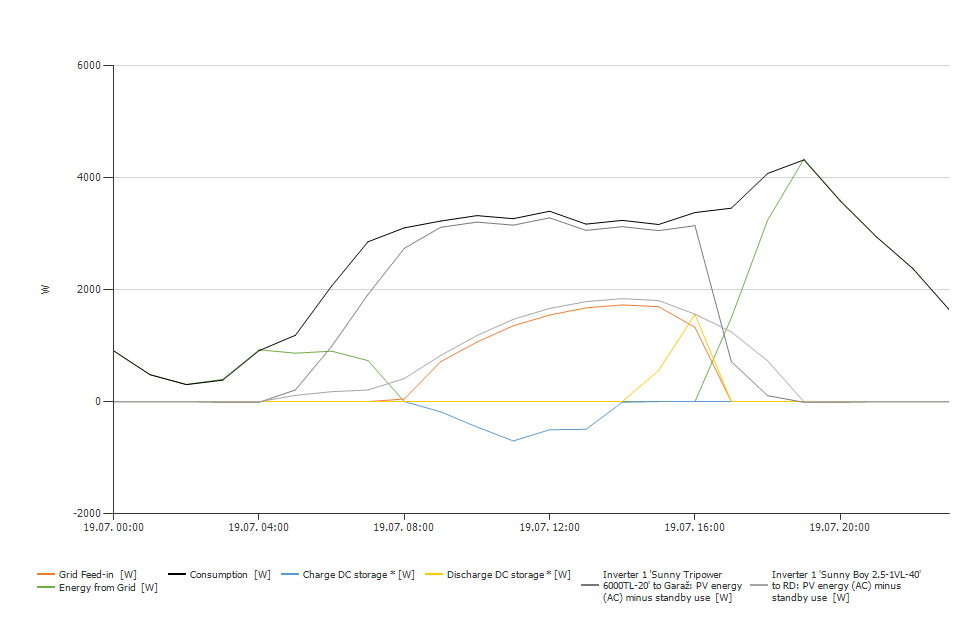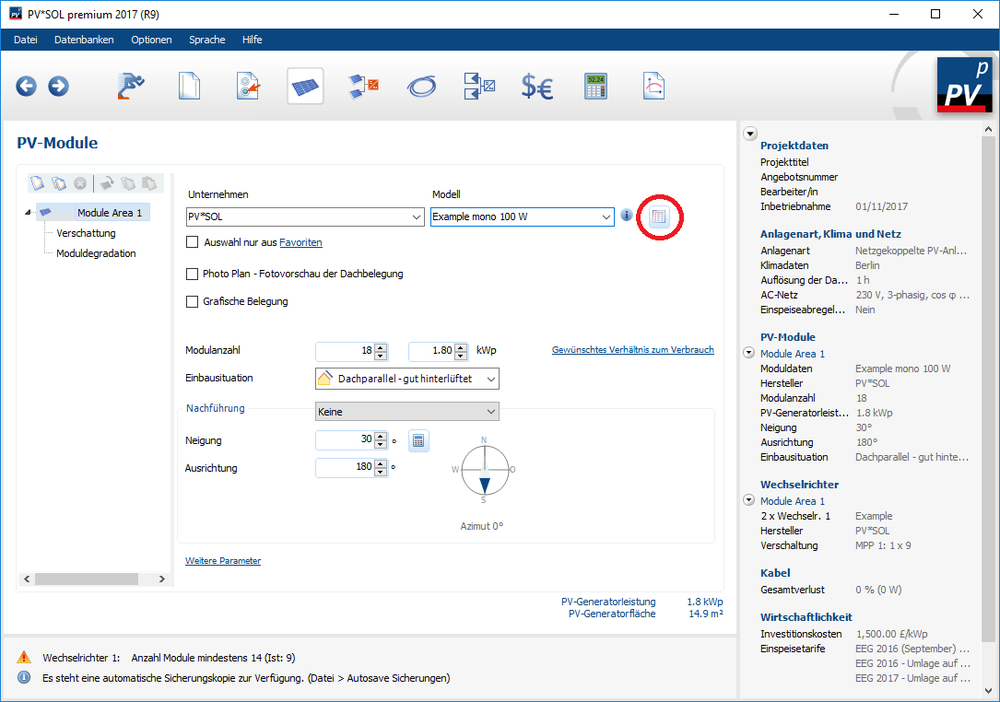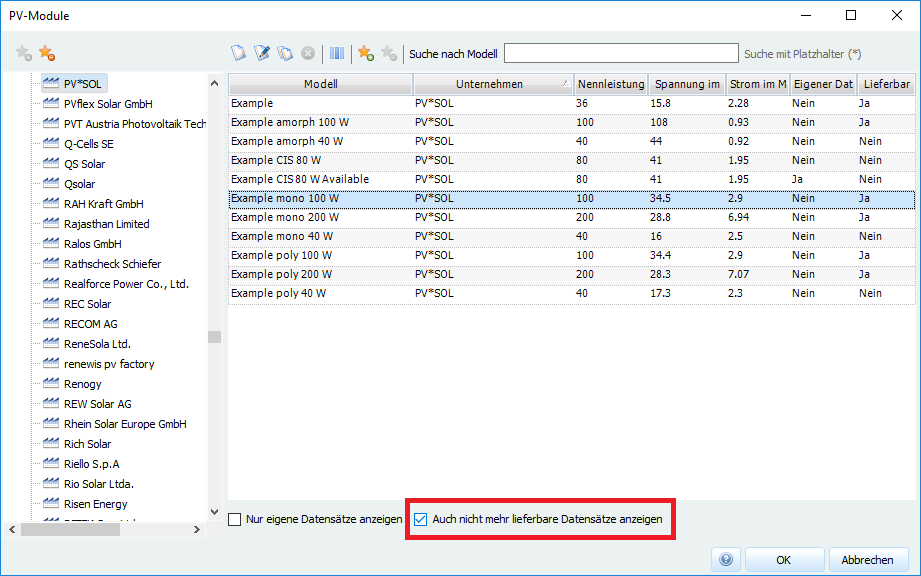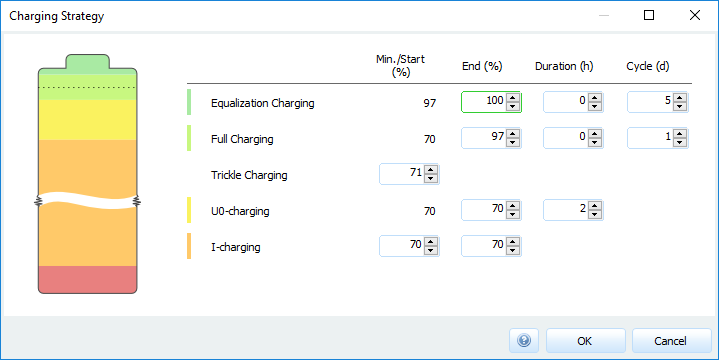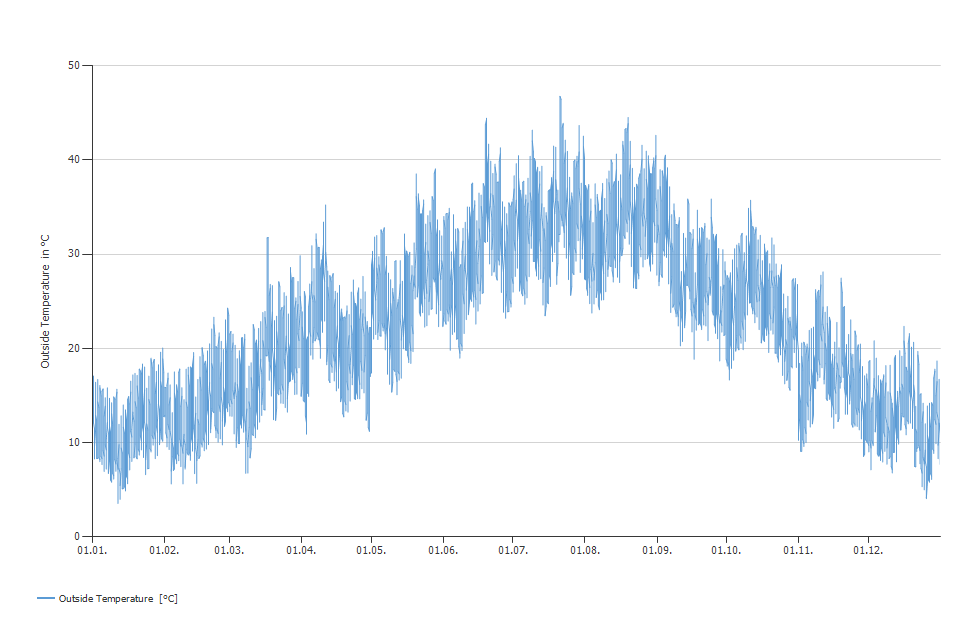-
Posts
1,845 -
Joined
-
Last visited
-
Days Won
172
Everything posted by developer_mh
-
Hi Diogo, no, unfortunately it is not possible to import the diffuse irradiance as well. But we have it on our list for the future. In the new version of PVSOL premium (2018 R1) that will be released in the next days, there will be new models for the diffuse irradiance, so that you can choose which one fits your measurements best: Hofmann (developed by us, the new standard model) Hofmann, M., & Seckmeyer, G. (2017). A New Model for Estimating the Diffuse Fraction of Solar Irradiance for Photovoltaic System Simulations. Energies, 10(2), 248. https://doi.org/10.3390/en10020248 Reindl with reduced correlation (only this model was available in previous versions PV*SOL®) Reindl, D.T.; Beckmann, W. A.; Duffie, J.A.: Diffuse fraction correlations; Solar Energy; Vol. 45; No. 1, S.1.7; Pergamon Press; 1990, http://dx.doi.org/10.1016/0038-092X(90)90060-P Orgill & Hollands Orgill, J. F., & Hollands, K. G. T. (1977). Correlation equation for hourly diffuse radiation on a horizontal surface. Solar Energy, 19(4), 357–359. https://doi.org/10.1016/0038-092X(77)90006-8 Erbs, Klein & Duffie Erbs, D. G., Klein, S. A., & Duffie, J. A. (1982). Estimation of the diffuse radiation fraction for hourly, daily and monthly-average global radiation. Solar Energy, 28(4), 293–302. https://doi.org/10.1016/0038-092X(82)90302-4 Boland, Ridley & Laurent Ridley, B., Boland, J., & Lauret, P. (2010). Modelling of diffuse solar fraction with multiple predictors. Renewable Energy, 35(2), 478–483. https://doi.org/10.1016/j.renene.2009.07.018 Boland, Ridley & Laurent (2010) Ridley, B., Boland, J., & Lauret, P. (2010). Modelling of diffuse solar fraction with multiple predictors. Renewable Energy, 35(2), 478–483. https://doi.org/10.1016/j.renene.2009.07.018 Perez & Ineichen Perez, R. R., Ineichen, P., Maxwell, E. L., Seals, R. D., & Zelenka, A. (1992). Dynamic global-to-direct irradiance conversion models. In ASHRAE Transactions (Vol. 98, pp. 354–369). https://doi.org/citeulike-article-id:10576695 Skartveit Skartveit, A., Olseth, J. A., & Tuft, M. E. (1998). An hourly diffuse fraction model with correction for variability and surface albedo. Solar Energy, 63(3), 173–183. https://doi.org/10.1016/S0038-092X(98)00067-X Kind regards, Martin
-
Hi Diogo, the numbers after the coordinates are height in m above sea level, negative time zone (for UTC+2 write -2) and an internal flag we used in the past, but don't use it anymore. So you will just have to adjust the height and the timezone. Kind regards, Martin
-
Dear Noé, the polymorphic interconnection will be available in our next release, along with a very sophisticated calculation of power optimizers (module integrated like Tigo or maxim, or external like SolarEdge). Then you will be able to connect everything to everything, with or without power optimizers. Right now we are working hard to get the new version released this week (PVSOL premium 2018 R1). Kind regards, Martin
-
Hi Kamal, you can easily do so in the 3D environment, if the modules have the same measures (width and height). If not, this will not be possible. To swap modules of an existing configuration, do the following: Select the "Module Coverage" dialog In the section "Define Reference Module" click on your module and choose "Select/Edit Reference Module" Click on the button "Replace" in the upper left corner (or right click on the module) Select the new module If the two modules do not have the same measures, you will see a message box telling you so Hope that helps! Kind regards, Martin
-
Hi Patrik, I understand your doubts. There are two differences of DC coupled systems that you should have in mind when you compare AC and DC coupled systems: The DC coupled storage is only connected to one of the PV inverters. That implies that the other inverters are never participating in charging the batteries and all PV energy of the other inverters is fed into the grid if it cannot be used to cover the load in that moment The charging power of DC coupled systems is subject to the available PV power of the inverter. Only if the PV power of that inverter is higher than the load, the excessive PV power is used to charge the batteries. In your case the systems behaves like in the graph below very often: During the day, between 08:00 and 16:00, the PV power of inverter 1 (dark grey) is sufficient to cover the load (black) Please note that the dark grey line is PV and battery power together (as it is DC coupled) Only the (little) excessive energy of inverter 1 is used to charge the batteries (blue) The energy of inverter 2 (light grey) is nearly completely fed into the grid (red) between 09:00 and 17:00, as the load is already covered by inverter 1 In the evening, the batteries are discharged to help cover the load (yellow), but as there is only a small amount of stored energy in them, they are rapidly empty - also compare the SOC of the batteries (purple): This leads to a very small amount of battery energy used over the year. Hope that clarifies the matter a bit. If you have further questions, please don't hesitate to ask! Kind regards, Martin
-
Hi Patrik, thanks a lot for your question and for providing the project file, that always helps a lot. In your case there is actually no error, the battery is working well. It is just that in die diagrams the yellow bars are representing PV energy AND battery energy together (see the text in the legend). For DC coupled systems, the PV and battery energy are fed into the system on one common point, so the energies are displayed together. In the table view for the simulation results, you can see, how much energy is stored into and taken from the batteries: Hope that helps, kind regards, Martin
-
Hi Boris, please contact our technical support team with your customer and license number, they should be able to track down the problem and fix it, no worries. contact: hotline@valentin-software.com https://www.valentin-software.com/en/sales-service/customer-service/technical-support Kind regards, Martin
-
Hi Damon, you can define your own individual appliances in the respective dialogue and then save it as vbi. User-independent appliances (the fan) User-dependent appliances (the laptop) If you click on "Save" on the right side, you can save and reuse it later. Kind regards, Martin
-
Hey Ahmad, thank you for your interesting question. While we cannot speak for EBRD or IFC, we have not heard of a project being rejected because it was designed in PV*SOL. What we experienced is that in Europe there is no difficulty in getting support from banks when producing PV*SOL reports. But in the end it all depends on the specific bank, the employee and of course on the project size (in EUR or USD). The bigger your project is, the higher will be the requirements for the project report. In general, you should be able to prove to the bank that you follow state-of-the-art design rules and use certified components. The IFC e.g. has a report where they point out what is important when designing PV projects in their eyes. And then, there is the bible or quran of PV system design, with (really) everything you need to know when you want to build PV plants: http://www.dgs-berlin.de/en/publications/internationalmanuals.html I would really recommend this to anyone associated with designing or constructing PV plants. Kind regards, Martin
-
Hallo Sebastian, da es sich bei deiner Anfrage um ein Offgrid (netzautarkes) System handelt, erlaube ich mir mal, deine Frage in ein neues Thema zu verschieben. Was die Offgrid-Auslegung angeht, stehen leider derzeit keine DC-gekoppelten Systeme zur Verfügung. Auch reine Laderegler sind nicht implementiert. In der neuen Version von PV*SOL premium, die gerade in der beta-Phase ist, ist es dann aber möglich, beliebige Batterie-Wechselrichter anzulegen, sodass man auch kleinere Laderegler damit nachbilden kann. Auch 12V oder 24V Systeme sind dann (rechnerisch) möglich. Beste Grüße, Martin
-
Hallo Leman, man kann im Kartenimport auch beliebige eigene Bilder als jpg, bmp oder png laden: Also einfach einen Screenshot der Google Maps Karte auf der Festplatte speichern und hier reinladen. Der Maßstab aus dem Google-Screenshot sollte dann verwendet werden, um die Pixel/Meter einzutragen. Gutes Gelingen! Martin
-
Hi Ahmad, you can search new locations either by their name or by zip code, and then click on the map to set the coordinates. Right now you cannot enter the coordinates directly, but we already have this tweak on our list. Perhaps the easiest right now would be to search your coordinates with maps and then relocate the point as accurately as possible in our climate data module, MeteoSyn. After synthesizing you can see the coordinates in the list view. Hope that helps for the moment, kind regards, Martin
-
Hi Kamal, thanks for your kind words! Unfortunately it is not possible to have standard values for the module degradation other than 100%. What you could do is to define kind of a template project where you set your module degradation to 90% and then preload it every time you start a new project. Kind regards, Martin
-
Hi Ahmad, In the end it is all about safety and warranty. It is right of course that an irradiance of 1000 W/m² is very improbable to occur when the temperature is 6°C, it is just that you want to make sure that these voltages are the absolute minimum that can occur. You can also just input higher tolerance values in PV*SOL if the standard values are too strict: But I am not going to suggest any standard planning or system design values to you. In the end you will have to clarify these questions with the people you are working for, or ask the inverter manufacturer for recommended voltage limits. Beste wishes, Martin
-
Hallo Bene, ja, das scheint ein Bug zu sein, dass der Lieferstatus nicht übernommen wird. In der neuen Version, die sich gerade im Beta-Test befindet, tritt der Fehler nicht mehr auf. Aber eine Auslegung können Sie ja in jedem Fall trotzdem machen, das geht auch mit nicht lieferbaren Modulen/Wechselrichtern/etc. Einfach auf der entsprechenden Seite, zb PV-Module, neben der Schnellauswahl den Datenbank-Dialog öffnen: Dann unten das Häkchen setzen bei "Auch nicht mehr lieferbare Datensätze anzeigen": Das gewünschte Modul auswählen und fertig. Beste Grüße, Martin
-
Hi Ahmad, yes, this is possible of course. You can use the form for the reactivation of the software here: https://www.valentin-software.com/en/downloads/order-forms You send it to our sales team (sales@valentin-software.com), they will reset your license and then you can reactivate your license on the other computer. If you have further question, you can also always contact our sales team directly. Kind regards, Martin
-
By the way, here is an overview over the new features of the next release: https://www.valentin-software.com/en/news/product-announcements
-
Hi Daniel, in the new version it will be possible to import a number of 3D formats into PV*SOL premium. The beta phase just started, so we look forward to release the new version by the end of November/beginning of December. Dwg files will not be supported in the first place, however. The final list of supported formats is not yet fixed, but at the moment it looks like that .x, .obj, .dae, .blend, .3ds, .ase, .lwo, .ply, .stl and .ms3d will be possible to import. Kind regards, Martin
-

Hybrid PV / Diesel Generator Option with SMA Fuel Saver Controller
developer_mh replied to damonl's topic in PV*SOL
ok, I understand now. No, that is definetely not possible to accomplish right now. But is it never possible to cover the entire load with 100% PV on sunny days with these systems? That seems a bit odd to me... -

Hybrid PV / Diesel Generator Option with SMA Fuel Saver Controller
developer_mh replied to damonl's topic in PV*SOL
Hi Damon, you are right, these aspects are not implemented in the simulation right now. What do you mean by energy capacity? Are these values a percentage of the instantaneous load (power), or is it in terms of daily or annual energy share? Kind regards, Martin -

Hybrid PV / Diesel Generator Option with SMA Fuel Saver Controller
developer_mh replied to damonl's topic in PV*SOL
Hi Damon, while we haven't implemented the exact control mechanisms of the SMA Fuel Saver, you could do the following to mimic a hybrid PV system: Go to the battery and battery inverter page, select the first cluster in your system configuration Click the "Battery Management" link Disable the battery as good as possible with these settings: It will not be possible to avoid their usage completely, but you can limit their participation quite effectively, so that your load will be covered by PV and diesel only: Hope that helps, kind regards, Martin -
Hi Daniel, a very good question you ask there. There are different approaches when dealing with climate data over a long period of time. And as always, there are pros and cons for every approach. The approach most people use is to compile a representative collection of days out of the measurements of the past 10 or twenty years, a so-called typical meteorological year (TMY). The climate data we use is from MeteoNorm, and they use data over a period of twenty years, sometimes 10, sometimes 30. That means, in the final dataset the hourly values of one day are not averaged or max/min-ed over the years, but taken from one specific year. The data for the next day are then taken from another year, perhaps. You will find a lot of information on how TMY are compiled on the internet, here is a good start: https://www.nrel.gov/docs/fy08osti/43156.pdf But you are totally right, the amount of self consumable solar energy at a given moment depends strongly on the specific value of solar irradiance at the given hour (or minute) and it would change perhaps significantly depending on which measurement year you use. It is important to understand that TMY data do not give any guarantee regarding the values at a specific point in time. What they guarantee is that the data over the year is typical for the location in question, that it is very probable. And while you cannot quantifiy the probability of a specific value for a given point in time, you can quantify the overall uncertainty of your climate data. Here is a good presentation to start: http://www.meteonorm.com/images/uploads/downloads/Accuracy_of_Meteonorm_7.pdf The same problem you'll have with the load profile by the way. Perhaps you have measured the load profile of one year for a given household or company. But there is no guarantee that the 3kW that you measured on January 2nd at 9am will really occur in reality afterwards. But good news is that there are also standardized "typical" load profiles for households and different kinds of enterprises that minimize the uncertainty over a year. But no, they do not solve the actual problem you mentioned. The only solution I could think of would be to use all twenty datasets for solar irradiance from the last twenty years and make twenty simulations, and then have a look at the minimum, maximum and average self-consumption. And then you would have to repeat that with several years of load measurements. I don't know if this is feasible But it would be a very interesting research topic! Kind regards, Martin
-
I really don't know what a recommended temperature for West Tunisia would be. In PV*SOL, I had a look at the climate data from Tozeur/Nafta, and the temperature looks like this: Minimum ambient temperature seems to be around 4°C. The cell temperature usually is higher, due to the irradiance, so I think if you go with 0°C cell temperature, you should be safe, even for worst case scenarios. But perhaps there are local guidelines you could follow? Kind regards, Martin
-
Hi Ahmad, thanks for your question! This temperature refers to the cell temperature. In STC (Standard Test Conditions, for measuring the nominal power, voltage and current), you'll have 25°C for cell temperature at 1000 W/m². But when configuring a system, you also want to make sure that a certain voltage is never exceeded by your PV array, so you'll calculate with lower cell temperatures. So you have to estimate the lowest ambient temperature at the given location (at daytime of course). For Europe, you normally just use -10°C at 1000 W/m² and you are on the safe side. Does that answer your question? If not, do not hesitate to ask! Cheers, Martin
-
ok, please check your private messages.
- 3 replies
-
- minute values
- error
-
(and 2 more)
Tagged with:


